The Prediction of Success in Project Management – Predictive Project Analytics at Deloitte

Over 60 percent of projects experience failure, resulting in higher costs, time overruns, or shortcomings in the desired outputs. Effectively no tools exist that allows forecasting which projects will fail and what can to be done to counteract risks. Predictive Project Analytics addresses these issues and allows organizations to better understand project complexity against maturity of existing governance models and control mechanisms in order to identify and avoid sources of failure.
Article by:
Jochen Fauser, Partner Technology
Markus Schmidthuysen, Manager Technology Advisory
Benjamin Scheffold, Consultant Technology
In the changing global economic landscape it is vital for organizations to stay competitive and reduce costs. Replacing outdated technology, improving business processes and implementing new programs are examples of activities that organizations undertake to face these demands. The increased pressure to deliver capital, business and technology projects within budget, specifications and schedule makes it necessary to avoid or at least soften risks and challenges that could compromise the desired outcomes of projects. Capabilities to manage project risk and guarantee effective governance, supported with insights from powerful analytical techniques, are needed to enable project and business transformation success.
This article summarizes typical challenges which business and technology projects currently face, and how Deloitte’s Predictive Project Analytic approach can help to address these. The different phases of the approach are introduced briefly and benefits are illustrated with a real client example.
1. Introduction
Success and growth in business is often tied to an organization’s ability to effectively manage major capital investment projects, streamlining business processes and the implementation of new technologies. Project management has gained importance in order to address the ongoing concern of value creation for organizations. Complex social, economic, and business issues have raised project management to a new level of strategic importance and delivered a new set of challenges that organizations need to face. Yet, despite the inherent strategic importance of projects, cost overruns, outcomes that don’t meet agreed requirements, or even entire project failures are experienced frequently.
The yearly CHAOS research of the The Standish Group, covering 50.000 company projects, illustrates that over 60 percent of organizations experienced failure. Drilling down into more detail reveals that time overruns are the primary issue that 74 percent of the challenged projects face, followed by shortcomings in developed features (69 percent) and higher costs than planned with 59 percent. Bloch, Blumberg, and Laartz (2011) confirm these as the key challenges organizations experience and add that in some cases project failed so badly that they threatened the existence of the company.
There are diverse reasons for project failure, ranging from the constant pressure of in-house teams to deliver in less time and at lower cost, poorly defined requirements, and lack of access to specialist resources. Due to the potentially repercussions of failure, organizations have always searched for ways to keep projects on track and improve their performance. As an example, academic research provides insights on factors affecting success and failure, but cannot provide methods or tools to predict the outcome of particular projects or individual phases. Traditional risk assessment, on the other hand, is based on expert knowledge but lacks the ability to pinpoint specific control gaps that can cause a project to go off the rails. And virtually no tools exist that allows the prediction of which projects will fail and what needs to be done to get them back on track.
Even in large and complex projects, risk management does not receive sufficient focus as part of project management, until the risks materialize as issues. Potential risks identified by risk analysis in early stages are typically filed away and not actively checked and monitored. In later phases of the project, when potential risks emerge, mitigation and remediation strategies are used to counter these risks, but their impact on the project as a whole is often not comprehensively considered. Risk management can further be hampered in global and large-scale projects as the high number of resources, activities, stakeholders, and deliverables involved, adding even more complexity to the situation. In combination with conflicting objectives and priorities among stakeholders, scenarios can be created that lead to projects with high expectations but little success. Such projects often come with an increased likelihood of cost and schedule overruns.
There is a demand for new approaches to assess the health and reliability of projects and transformation initiatives, better equipping project management to deal with large and complex projects. Predictive Project Analytics (PPA) is a project risk assessment methodology that originates from data analysis and predictive analysis. It allows the forecasting of potential risks at project kickoff, and identification of pre-emptive risk mitigation actions for ongoing programs.
Veröffentlicht mit freundlicher Genehmigung der GPM Deutsche Gesellschaft für Projektmanagement e.V. Erstabdruck in Projektmanagement aktuell, Jahrgang 2015, Heft 5, S. 66 – 74.
read more



